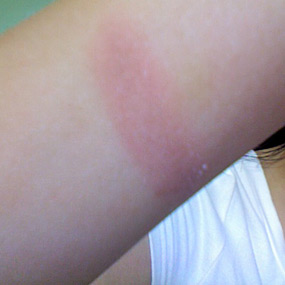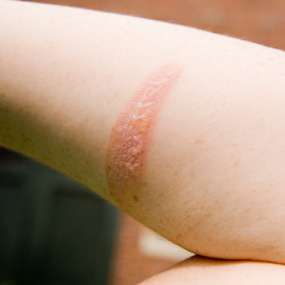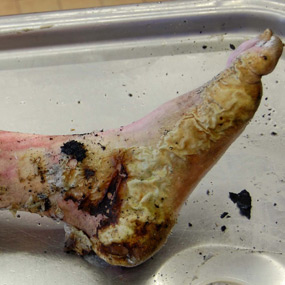Medically Reviewed by George Krucik, MD, MBA on August 13, 2014
Overview
Burns are
among the most common household injuries, especially in children. The term
“burn” means more than the burning sensation associated with this injury. Burns
are characterized by severe skin damage in which many of the affected cells
die. Depending on the cause and degree of injury, most people can recover from
burns without serious health consequences. More serious burns require immediate
emergency medical care to prevent complications and death.
 First-degree burns
cause minimal skin damage. They are also called “superficial burns” because
they affect the outermost layer of skin. Signs of a first-degree burn include:
First-degree burns
cause minimal skin damage. They are also called “superficial burns” because
they affect the outermost layer of skin. Signs of a first-degree burn include:
First-degree burns are mostly treated with home care. Healing time may be quicker if you treat the burn sooner. To treat this type, you can:
 Second-degree
burns are more serious because the damage extends beyond the top layer of skin.
This type of extensive damage causes the skin to blister and become extremely
red and sore. Some blisters pop open, giving the burn a wet appearance.
Second-degree
burns are more serious because the damage extends beyond the top layer of skin.
This type of extensive damage causes the skin to blister and become extremely
red and sore. Some blisters pop open, giving the burn a wet appearance.
Due to the delicate nature of such wounds, frequent bandaging is required to prevent infection. This also helps the burn heal quicker. Some second-degree burns take longer than three weeks to heal, but most heal within two to three weeks. The worse the blisters are, the longer the burn will take to heal. In some severe cases, skin grafting is required to fix the subsequent damage. Skin grafting borrows healthy skin from another area of the body and replaces it at the site of the burned skin.
As with first-degree burns, avoid cotton ball wraps and questionable home remedies. You can generally treat a mild second-degree burn by:
 Third-degree
burns are the worst burns. They cause the most damage, extending through every
layer of skin. The damage can even reach the bloodstream, major organs, and
bones, which can lead to death.
Third-degree
burns are the worst burns. They cause the most damage, extending through every
layer of skin. The damage can even reach the bloodstream, major organs, and
bones, which can lead to death.
There is a misconception that third-degree means most painful. With this type of burn, the damage is so extensive that you may not feel pain because your nerves are damaged. Depending on the cause, third-degree burns cause the skin to look:
Burn Levels
There are
three primary types of burns: first-, second-, and third-degree. Each degree is
based on the severity of damage to the skin, with first degree being the most
minor and third degree being the most severe. Damage includes:
Burns have a variety of causes, including:
- first-degree burns: red, non-blistered skin
- second-degree burns: blisters and some thickening of the skin
- third-degree burns: widespread thickness with a white, leathery appearance
Burns have a variety of causes, including:
- scalding from hot, boiling liquids
- chemical burns
- electrical burns
- fires, including flames from matches, candles, and lighters
- excessive sun exposure
First-Degree Burn
 First-degree burns
cause minimal skin damage. They are also called “superficial burns” because
they affect the outermost layer of skin. Signs of a first-degree burn include:
First-degree burns
cause minimal skin damage. They are also called “superficial burns” because
they affect the outermost layer of skin. Signs of a first-degree burn include:- redness
- minor inflammation (swelling)
- pain
- dry, peeling skin (occurs as the burn heals)
First-degree burns are mostly treated with home care. Healing time may be quicker if you treat the burn sooner. To treat this type, you can:
- soak the wound in cool water for five minutes or longer
- take acetaminophen or ibuprofen for pain relief
- apply aloe vera gel or cream to soothe the skin
- use an antibiotic ointment and loose gauze to protect the affected area
Second-Degree Burn
 Second-degree
burns are more serious because the damage extends beyond the top layer of skin.
This type of extensive damage causes the skin to blister and become extremely
red and sore. Some blisters pop open, giving the burn a wet appearance.
Second-degree
burns are more serious because the damage extends beyond the top layer of skin.
This type of extensive damage causes the skin to blister and become extremely
red and sore. Some blisters pop open, giving the burn a wet appearance. Due to the delicate nature of such wounds, frequent bandaging is required to prevent infection. This also helps the burn heal quicker. Some second-degree burns take longer than three weeks to heal, but most heal within two to three weeks. The worse the blisters are, the longer the burn will take to heal. In some severe cases, skin grafting is required to fix the subsequent damage. Skin grafting borrows healthy skin from another area of the body and replaces it at the site of the burned skin.
As with first-degree burns, avoid cotton ball wraps and questionable home remedies. You can generally treat a mild second-degree burn by:
- running the skin under cool water for 15 minutes or longer
- taking over-the-counter pain medication (acetaminophen or ibuprofen)
- applying antibiotic cream to blisters
- face
- hands
- buttocks
- groin
- feet
Third-Degree Burn
 Third-degree
burns are the worst burns. They cause the most damage, extending through every
layer of skin. The damage can even reach the bloodstream, major organs, and
bones, which can lead to death.
Third-degree
burns are the worst burns. They cause the most damage, extending through every
layer of skin. The damage can even reach the bloodstream, major organs, and
bones, which can lead to death. There is a misconception that third-degree means most painful. With this type of burn, the damage is so extensive that you may not feel pain because your nerves are damaged. Depending on the cause, third-degree burns cause the skin to look:
- waxy and white
- charred
- dark brown
- raised and leathery













0 komentar:
Post a Comment